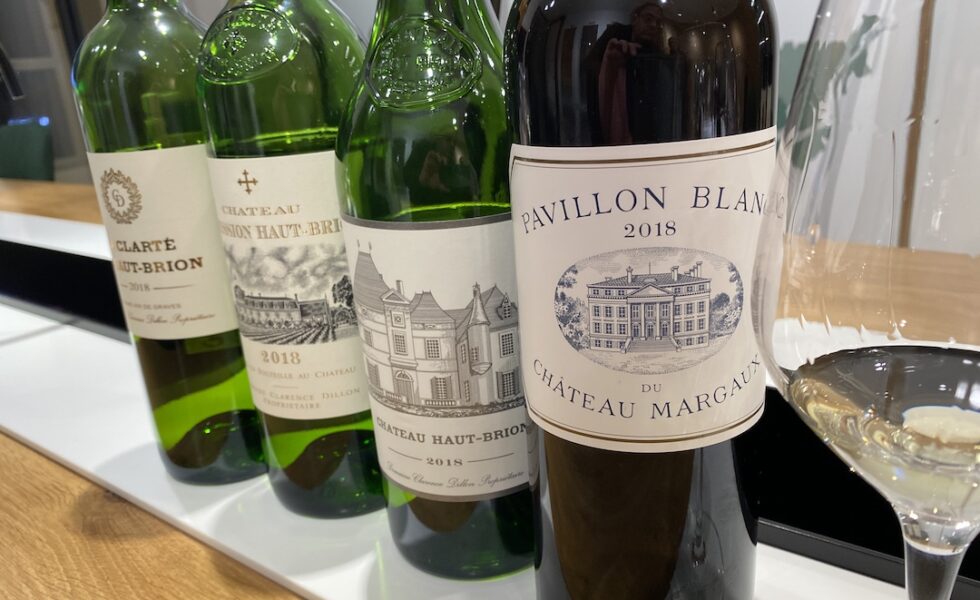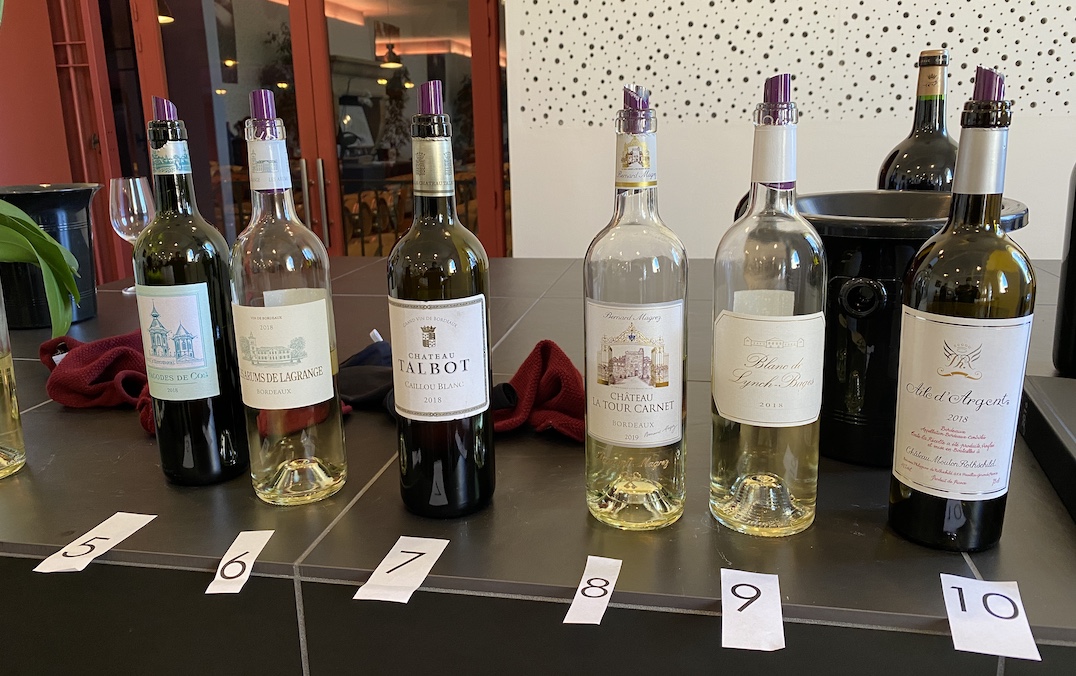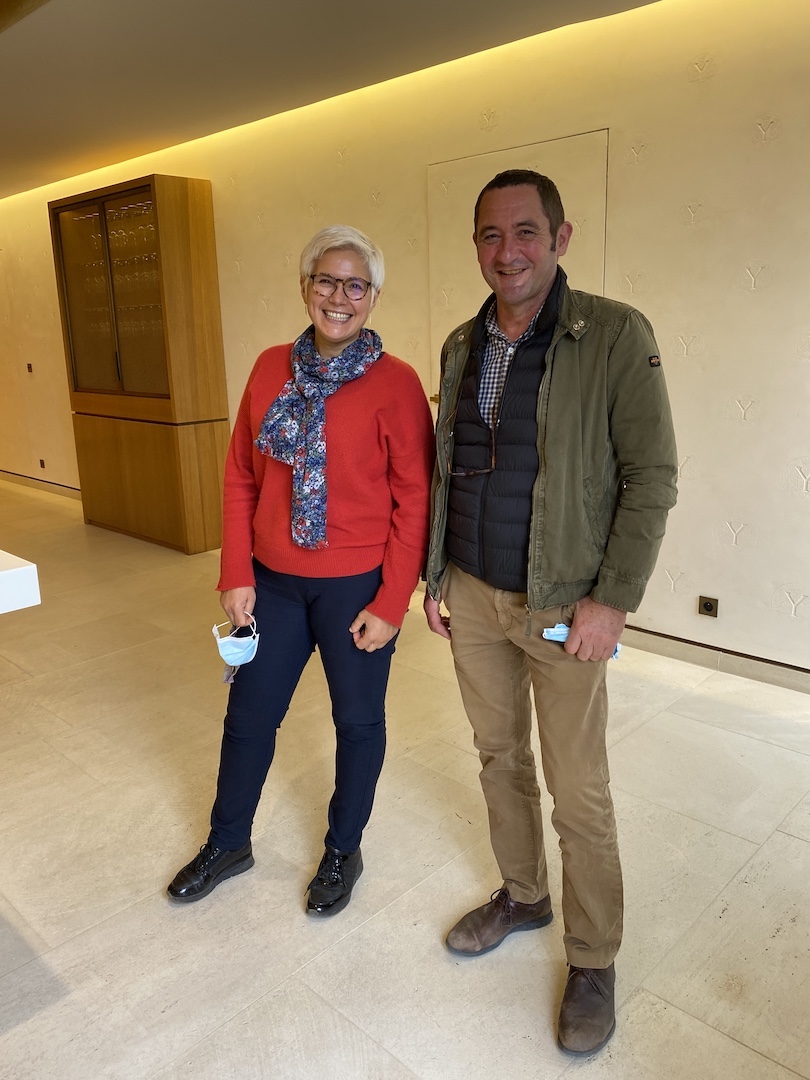Bordeaux 2018 dry whites

Some excellent wines in a challenging vintage
By Panos Kakaviatos for wine-chronicles.com
24 January 2021
The warmth of the vintage not truly ideal for dry whites, some producers did craft excellent wines, including some from outside the famous Graves (including the northern Pessac-Léognan appellation) region, known for its dry white wines. While tasting the dry whites crafted by producers in Barsac and Sauternes, Jean-Jacques Dubourdieu of Château Doisy-Daëne in Barsac poured wines on behalf of fellow producers. “You had to be reactive for the dry whites to maintain freshness”, he said. “But since we are on limestone, in Barsac, we were able to have that freshness.” The key was to have proper pH. “You had to harvest early” to maintain that acidity, he added. The dry whites were picked at end of August or latest first week of September for many estates. Tasting notes here divided into three parts (Part 1 Pessac-Léognan, Part 2 Mostly Médoc estate whites, although one excellent Fronsac, too -the hyperlink takes you there immediately – and Part 3, Dry Whites made by Sauternes and Barsac producers).
As usual, wines in bold, I liked especially. If red and bold, even more. If underlined, too, a kind of wine nirvana.
Part 1: Pessac-Léognan and Graves
Most Pessac Léognan wines were tasted in Bordeaux non blind with Jane Anson, while the Domaine Clarence Dillon wines were tasted at the CIVB in Bordeaux non blind.
Château Bouscaut – The acacia and honeyed aspects from this blend of 68% Sauvignon Blanc and 32% Semillon, having aged in 40% new oak, are clear but there also is freshness here. Sure, it comes across a touch warm, like some 2018s but I like the wine’s endearing honeysuckle and sweet floral aspects. 14% alcohol. 92
Château Carbonnieux – This blend of 70% Sauvignon Blanc and 30% Semillon clocking in at 13.5% alcohol is one of the more successful whites from the vintage. Typically “cool” in aromatic expression, perhaps somewhat varietal, too, but lots of juiciness on the palate and it comes across refreshing, with grapefruit zing even if a touch under powered. I like the tanginess on the finish! 93
Château Couhins – This 100% Sauvignon Blanc clocks in at 14.5% alcohol, and is quite reductive from bottle but the palate is better with freshness and some ripe Kiwi. Rather nice indeed, as I do not get the too much vintage heat. Maybe the real alcohol is closer to 14%. I like the juicy mid palate sap, even if one senses a touch of heat on the finish. One of the more successful dry whites of the vintage. 93
Château Couhins Lurton – One of the stars of the vintage, this 100% Sauvignon Blanc, and not just for the excellent price/quality ratio at under €30 per bottle. It communicates drinkability, is not obviously rich or sweet à la 2018, but rather refined, and focused, in approach with fine tension overall. Very well done! Bravo. No guts, no glory! 94

Several bargains in 2018 for dry white Bordeaux, and here an excellent example.
Domaine de Chevalier – This blend of 75% Sauvignon Blanc and 25% Semillon exudes lemon meringue pie on the nose, leading to a creamy richness and distinct opulence on the palate with density. Again the cooler microclimate helps. Talk about impressive dry extract! It just needs time to coax out the expressiveness at this very early stage. And yet, I think that this estate has more to offer in 2019 from its white, as the freshness factor is more pronounced in 2019. Still, a top white for 2018. 95
Château de Fieuzal – Tropical fruit aspects on the nose. Kiwi and pineapple to be sure, and the juicy attack beguiles you. And yet it seems to lack the density and length from a better vintage. To be enjoyed for a shorter term. 92
La Clarté de Haut Brion – A second wine to the Haut Brion Blanc, but I liked it just as much for its evident lime freshness. This blend of nearly 80% Semillon and the rest Sauvignon Blanc is indeed almost more appealing than either of the two “first wines”, as experienced from barrel, and again from bottle! Maybe because of the lower alcohol balance, at 13.8% with a pH of 3.44 pH. It does not match the breadth of either of the first wines, its price is more interesting in this vintage for most consumers. 93+
Château La Mission Haut Brion Blanc – Clocking in at just over 14% alcohol, this blend of 57.4% Sauvignon Blanc and 42.6% Sémillon, having aged in about 50% new oak, reveals excellent density and breadth from bottle, with superior grip to the Haut Brion Blanc and with greater energy and verve. With a pH of 3.27 – slightly lower than at Haut Brion – the aromas and flavors evoke freshness, wet stone and pear, quite lovely. However, like most all dry white wines from this vintage, it is not the best-ever. An impressive showing, however. 95
Château Haut Brion Blanc – With over 80% Sauvignon Blanc, the wine clocks in at 14.4% alcohol and with a pH of 3.37 (same as in 2009). Recall how estate representative Turid Hoel-Alcaras had explained from barrel that the white vintage was not easy. The acidity in Semillon was “dropping quickly”, so they sold off much Semillon originally meant for the grand vin to make the Clarendale Blanc as well as into second wines. And from bottle, the wine again seems to lacks the grip of the La Mission, which I prefer. Yes, there is impressive density, and juiciness, with pleasing and distinct white stone fruits like pear and white apricot, but it comes across a bit short (for an estate of such high calibre) on the finish, which at least evokes fresh lime and lemon. If you want an expensive Haut Brion white, go for the 2017. 94+
Château Latour Martillac – I liked the initial aromas of chamomile and white pepper, and some upfront white stone fruit, but this blend of 54% Sauvignon Blanc and 46% Sémillon clocking in at 13.5% alcohol seems to lack that enough verve to arouse more excitement: my hopes were higher from barrel. At least there is freshness on the finish. 92
Château Malartic Lagraviere – Like so many 2018s the freshness factor is not as pronounced so the better wines can make up for that in dry extract and density. This blend of 90% Sauvignon Blanc and 10% Semillon conveys an apple cobbler like sensation of sweet opulence, but also juicy ripe pear. I like the smooth palate texture, full body and impressive dry extract, leaving the taster with an impressive sensation of breadth. 14.5% alcohol. 94
Château Olivier – I like the honeysuckle aspects on the nose from this blend of 75% Sauvignon, 23% Sémillon and the rest Muscadelle. My impression is better than it was from barrel, as the wine displays some vigor and brightness and spice even if the finish is a touch abrupt. 13.5% alcohol. 92
Château Pape Clement – I was expecting more as my impressions from barrel of this blend of 57% Sauvignon Blanc, 39% Sémillon and 4% Muscadelle having aged in just over 55% new French oak barrels were more effusive. Yes, pleasing flavors and aromas of orange rind, wet stone, tropical and spicy notes. But the palate lacks enough energy and vigor and enough freshness for the pedigree (and price). 14% alcohol 92
Part 2: Mostly Médoc estates tasted blind at Château Belgrave, unless otherwise indicated
Aile d’Argent – A somewhat dark hue. While the 2019 is a success, as tasted back in the summer of 2020, the 2018 comes across somewhat fat on the palate. Sure, plenty of richness and breadth, but it kind of wobbles on the finish. 92+
Alto de Cantenac Brown – White stone fruit. Pear liqueur. Solar vintage, but pleasing to drink, fun. A hint of hazelnut however on the finish? 92
Arum de Lagrange – This exudes fine depth on the palate. Albeit some hazelnut aspects. I prefer this to the Caillou Blanc, tasted just before in the blind tasting. Requisite acidity. 91+
Le Blanc de Lynch Bages – Wrigley Spearmint Gum on the nose. Some citrus and white stone. Balanced and flavorful, this wine has acidity and roundness. A favorite among the whites! 93+

Mystery unveiled!
Le Blanc du Prieure Lichine – Nose is a touch austere. Not as “giving” here. Palate has freshness, again, as in the the Alto de Cantenac Brown, tasted just before. More Kiwi and pineapple. And it rather bursts with tropical fruit aspects, juicy. This is fun and better than the nose may suggest. 93
Le Blanc de la Tour Carnet – A somewhat lackluster showing from this bottle. 87
Caillou Blanc – Noticeably dark color here. I took a photo of two previous wines at the blind tasting and the color difference astounds. Some hazelnut aromas but the palate opulent and even full bodied. Based on this bottle, do not wait at all. While other wines (tasted blind) have more longer term potential, this has decadence for current drinking. 88
Cos d’Estournel Blanc – At the blind tasting at Château Belgrave, this was corked, so I went to the estate in December 2020. The blend of 33% Semillon and 67% Sauvignon Blanc exudes refined white stone fruit. Pear. One of the best dry whites from the vintage, delicious, with “sheen” on the palate, smooth, and generous. Fine acidity and a low pH of 3.06. Cooler clay and limestone helped. There is a strict aspect “droit” as technical director Dominique Arangoïts says. Bravo! 95
Pagodes de Cos – Color is slightly darker than the first wine and not quite as precise. Blending 93% Sauvignon Blanc and 7% Semillon, the second wine – tasted both at the estate and blind at Château Belgrave – conveys decent freshness, but there is a more pineapple aspect. Still, the palate is fresh with even a hint of silex. 91
Pavillon Blanc of Château Margaux – I think that this may just be the dry white Bordeaux of the vintage, among those that I had tasted. Very agreeable nose and this wine beats the already promising expectations from barrel. You see, the grapes were all picked in late August to preserve freshness, so the wine ends up with low 3.1 pH. Less lees stirring to reduce exposure to oxygen and larger than normal oak barrels to reduce surface contact with the oak. From bottle an initial reductive hint, but what a refreshing palate, with bright fruit (green apple and juicy white stone fruit), fine tension and freshness, so the wine comes across fresher than most would have expected from the vintage. Some rains in July had helped to retain enough freshness and thanks to the age of the vines, you get a bit more acidity. The juicy thirst quenching aspect defies the ultra warm vintage. 96
Tertre Blanc – Banana notes? They do depart with time in glass, leading to a rich sensation. Does not have the most ideal precision, but I can imagine this with fettucini alfredo and shrimp. And the blend is fascinating:
42% Chardonnay, 11% Sauvignon Blanc, 16% Viognier and 31% Gros Manseng. Nice gastronomic white! 92
Part 3: Dry Whites made by Sauternes and Barsac producers
In recent years, more estates known for their late harvest “sweet wines” have been crafting dry whites, seeing that dry whites can sell better, in terms of market realities. Indeed, some estates have not one, but two dry whites! As said before, the heat of the vintage 2018 was not idea for dry whites, but some did better than others. The quality is overall excellent, and I dare say that in a vintage more amicable for dry whites, we would see higher scores. Scroll down for the Yquem dry white, which was not tasted blind.
Tasted blind at Château Doisy Däene in Barsac : spontaneous notes, on the spot!
- Chipper enough, has acidity but not quite the evident verve and body you want. Tastes like an Entre-Deux-Mers for the apéro. Clean. M de Malle of Château de Malle. 88
- This has more verve, a bit more sap. A bit more interest. You feel a touch of warmth on the palate however. And yet, serve chilled, and it can go with a more gastronomic dish. Or at least pasta in a cream sauce. Duo de la Tour Blanche of Château La Tour Blanche. 90
- First bottle was corked. They had to call the estate, so we knew that this was not Doisy Daene. Second bottle: this is robust and tasty, not the longest, but more classical in approach. Nice job! S de Suduiraut. 90
- Sweet nose aroma. This has some sap driven refinement, and near full body. Quite nice, although one could tell that the vintage is a solar one. Just a touch of fat. Asphodele de Climens of Château Climens (Semillon 100%). 90.
- This is spearmint and fresh on the nose, with much palate density that appeals. And it has some weight, which I like. Noticeably dark color. A bit of heat, and you want served chilled. Semillon de Sigalas (100% Semillon). 90
- Very pineapple and fresh on the palate and nose. Much lighter color as compared to the #5. Has appeal. Doisy Daene Grand Vin Sec 100% Sauvignon sur calcaire. More classic when tasted next to #4. 91+
- A kind of compressed aspect on the palate. The nose is a bit underwhelming. It has a tannic edge to it, but the bitterness is not to my liking. It goes a bit too far in that regard. But I admit as Yohan noted, that it has intensity. Clos du Hez Blanc de La Motte Guignard. 87
- This is a better wine, just after #7, as it has more verve and density. I like this one quite a bit for its fresh white stone fruit and touches of tropical, nicely balanced by the acidity. It is more classic and there is sulfite. Le Sec de Rayne Vigneau of Château Rayne Vigneau. 91
- Nice density on the palate even if the nose seems a bit closed in. This has smooth nature, with ripe fruit. I like a hint of tropical but there is elegance even. Smooth. Opalie de Coutet of Château Coutet. 92.
- This is ok, it has a bit of flabbiness on the finish but the body is there. Actually there is quite a bit of body and really fills your mouth with wine! Very nice. But there is a hint of warmth here. Serve chilled. Suduiraut Blanc Sec (less expensive than S de Suduiraut) 91
At Château d’Yquem
Preceding a fabulous lunch, about which I will post separately, we tasted the 2018 vintage wines produced at the estate (the Sauternes wine in the Sauternes section). Along with director Pierre Lurton and staff Francis Meyer (nearly 40 years with the estate), Sandrine Garbay and the recently arrived Lorenzo Pasquini.

At Château d’Yquem with Sandrine Garbay and Francis Meyer
Y de Yquem: Crystaline fruit, coolness, freshness and suave refinement. You have five grams of residual sugar but very well balanced. It was quite fascinating to experience such a fresh and tangy dry white from this vintage so kudos to the team for crafting a top dry white for the vintage. 94
 Wine Chronicles
Wine Chronicles
Share This